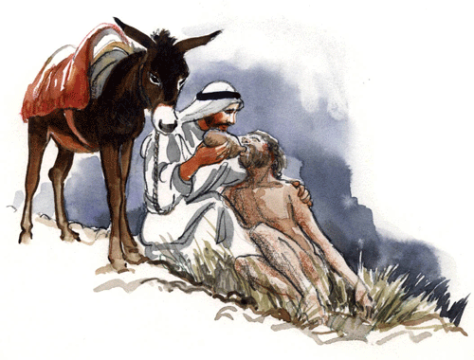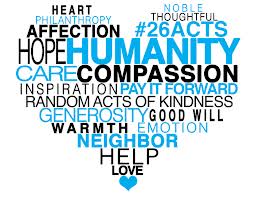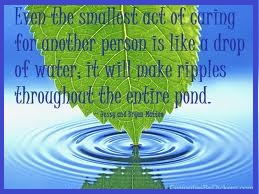Worship Sundays at 9 am
This content has been archived. It may no longer be relevant

used by permission, http://www.stoubgraphics.com/Illustration/GoodSamaritan.html
One to Another in Christ: Week 5
A “Good Sam” Fall Focus 2013
October 13, 2013
Theme
Developing a heart that is prepared to give is one of the great activities of those who are disciples of Jesus. When this happens for us, the work of God begins to multiply all around us in the abundance of community, peace, hope and every good work of God. How then can we know the person in the ditch is our Neighbor?
Prayer
As we turn our hearts to listen to you O Lord, you invite us to turn to our neighbors and care for them. Each week we pray to forgive others as we have been forgiven, teach us this O Lord, but also teach us to love others as you have loved us.
Lesson
The Parable of the Good Samaritan, Luke 10:25-37
Bible Study
1) Who is testing whom in this story?
2) Why does Jesus answer the Lawyers question with a story?
3) How might one explain or justify the actions of the Priest and Levite in this story?
4) What personal resources did the Samaritan make use of in helping the man in the ditch? What personal resources of yours do you think you might make available to help a neighbor?
5) What mindset does it take to be more like the Samaritan in the story rather than the Priest or Levite?
6) How might you go about having concern for the business of others while being about your own business?
7) What activities of Good Sam do you feel are most like those of the Good Samaritan in the story? Which are most like the actions of the Priest or Levite?
9) How Might Good Sam “go and do likewise?” as Jesus instructs the Lawyer.
10) How might you “go and do likewise?”
11) In what sense is giving at church or participating in fundraising activities a “practice or preparation” for making your resources available when they are needed?
12) Given the divisions between Jews and Samaritans of the time, what is unusual about the plot twist in this story? What is Jesus’ point here? Would the Priest, Levite or the man in the ditch have been available to help the Samaritan in similar trouble?
13) To whom will you be a Good Samaritan this week?
Sermon at Good Sam on October 13, 2013 (Week #5 of “One to Another in Christ.”
[youtube=http://www.youtube.com/watch?v=nsUYx1R3IrE&w=420&h=315]
Objectives
-
Explore the “managing to be neighbors” parable of Jesus. We call it the Good Samaritan Parable.
-
Discovering what condition of heart and mind make for being available to our neighbors.
-
Reflect on just who Jesus might be sending us personally and us collectively (Good Sam) to be neighbors to.
-
Let our stewardship opportunities in the church prepare us for faithful action with our neighbors outside of the church, so that when next we see a neighbor in the “ditch” we are free and available to help. Think about with whom can you be a neighbor and build community where you might not have before? .. go and do likewise. Get out there and do it… ” tell someone how you ran the race, or played the game or made yourself available to God’s work in the world.
Devotion
As a preteen I had an inauspicious career as a baseball player. The year I turned twelve I was given the honor of being promoted to the teams regular third base player. In honor of the event I bought a new baseball mitt. I was very proud to use it in that first game of the year. The new smell of that glove was so intoxicating.
In the eight inning of that game, there was a very hard hit line drive that was screaming right at my face. Instinct took over and my glove hand went up to protect me and the ball landed square in the webbing of that mitt. As it happened – the mitt being new and all – I couldn’t easily squeeze the new leather of the mitt closed, so the ball proceeded to drop right out of the mitt and on the ground. My was that embarrassing.
Taking the advice of my coach, I went home and oiled that mitt (it didn’t look quite so new now). I folded it closed as it should close and I put 10 encyclopedias volumes on it. After 3 days I took it out and oiled it again. This time I got dad to drive over it again and again. After that I opened and closed that mitt over and over again, really working the crease into the now natural fold of the glove. It really didn’t look new at all at this point, but soon that mitt would open with ease and close without my even thinking about it.
That next week on the baseball diamond, I was playing third base and again a screaming line drive was hit very hard in my direction. I again, reacted with pure instinct and my glove came up to protect my face. This time however, as the ball landed in the web of the mitt, the glove nicely and easily folded around it and refused to open until I opened the mitt and threw the ball to first base for a force out of the runner who now had to return to first. Two outs without really trying or thinking, and it was all due to that mitt being well broken in and ready for its task.
In our lives, the practice of pledging and regular giving can help us learn the pattern of responding to God’s gifts in our lives, so that when that moment comes where our presence and action are needed, we open and close and fall easily into the activity of making ourselves available to God’s working. Perhaps the folds and creases in our lives really do help prepare us for the real game of living in faith.
 Additional curriculum and ideas
Additional curriculum and ideas
-
Flat tire exercise, being prepared to render service; list the things you might have with you always so that you are prepared to render service along the road. When done ask “would any of you actually go out and prepare yourselves to be of service in this way?
-
Who do you think might be least likely to be of help to you, when you need it? How might you prepare yourself to be of help to them?
-
Spontaneity vs planned activity – does one of them seem more meaningful in actually giving help or support to another?
Examples
-
buying a sandwich for someone who seems like they need it. vs giving to the food bank.
-
spending time with someone who seems to need it when you might otherwise benefit from being somewhere else, vs giving regular time to a learning to read program.
-
planned giving vs increased regular and spontaneous giving.
-
Helping someone who imposes on your time by their request vs spending a whole day helping to clean up a neighbors yard and house (Christmas in April)


